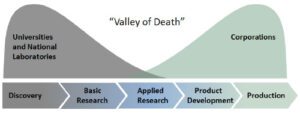
SRI International had the honor of hosting President Dilma Rousseff of Brazil and her top ministers during her recent visit to the United States. Brazil is a huge country with a wealth of natural resources and a population of more than 200 million. Yet, as it tries to move from an industrial-based economy to an innovation economy, it faces a number of issues. The challenges include how to compete with other emerging, more nimble nations of South America—as well as the world—for innovation, for attracting and encouraging new business and industries, and ultimately for creating jobs.
Our discussion focused on this challenge, and how SRI has worked with governments at the state, local and national levels to implement successful programs that identify basic research opportunities and help move them into the commercial sector.
One obstacle that SRI highlighted and that attracted President Rousseff’s interest is what is called the “Valley of Death” on the innovation road map. The Valley of Death is the funding, resources and “acceptability” gap that occurs between basic research and product development. In between those key points is applied research—the crucial middle step essential to taking basic research and moving it to where it’s commercially viable. At the left side of the continuum, there are universities and national laboratories that invest heavily in discovering new technologies or science as well as basic research. At the other end are corporations that develop products and services to meet the needs of customers.

What’s missing is the applied research step in between—identifying those breakthroughs that can make sense commercially, and filtering those that might be valuable as a commercial product. Investments in applied research are limited, as they are risky and expensive. Hence the moniker, “Valley of Death,” where much of the promising research, for various reasons, is not further developed and never makes it into production and commercialization. Institutions such as SRI focus much of their energy on this critical step in the process, but there is both a role and a real need for attention at national levels to bridge the gap. SRI, in fact, has developed a very sophisticated process to tackle and succeed at crossing the Valley.
Our discussion with President Rousseff centered on opportunities for a country such as Brazil that wants to spend more on research and development, but also wants to make sure those investments are in the right areas. For example:
- How can Brazil determine the best scientific areas to focus her resources?
- What’s the most efficient way of identifying areas that have the best chance of success, and nurturing them to the point where consumers’ needs can be met?
- How should a government help start-ups find the right people and overcome technical and logistical roadblocks?
- How does a government give the right funding at the right time to make these start-ups attractive for private investment?
In the end, Brazil wants to do what many governments are trying to accomplish: channeling limited resources in the most effective way to create more high-paying jobs, more industries, and more successful companies.
Photo, top right: Bill Jeffrey, SRI’s President and CEO, and Stephen Ciesinski, SRI’s President of Global Partnerships, greet Brazil President Dilma Rousseff upon her arrival to SRI on July 1, 2015.


